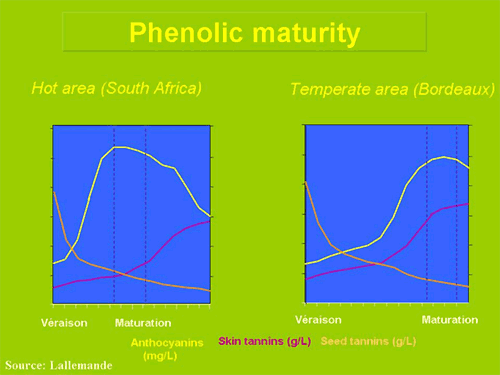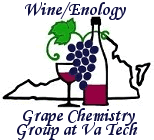Enology Notes
Enology Notes #118, September 26, 2006
To: Regional Wine Producers
From: Bruce Zoecklein, Head, Enology-Grape Chemistry Group, Virginia Tech
Subject: Tannins, Color, and the 2006 Season, Continued; VT Enology Service Lab; Enology Notes Index Expanded; Winery Planning and Design CD Available Soon
1. Tannins, Color and the 2006 Season, continued.As outlined in previous editions of Enology Notes, the phenolic compounds in grapes and wines are the result of a combination of genetic or varietal, climatic, viticultural, and processing factors. This continues a series adapted, in part, from a presentation titled “Grape and Wine Phenols,” that I conducted in Chile in late 2005.
Pigment Polymerization. As discussed in Enology Notes #116, grape and wine anthocyanin pigments can be either free monomers, that is, unbound, or associated with phenols and other compounds to form polymers.
Polymerization can impact the sensory quality of the pigments by increasing color stability, and by changing the spectral color from bright red to brick-red. Additionally, larger polymers are loosely associated with softer, less harsh astringency.
A limited degree of polymerization, and perhaps de-polymerization, occurs in the fruit during maturation. In wines, tannin polymerization continues (although there is some de-polymerization) until an anthocyanin molecule binds the terminal end, then polymerization is believed to stop. The ratio of free anthocyanins to tannins is important in impacting polymerization, due to the following:
- tannin and anthocyanin concentrations affect concentration of polymers
- too low tannin or anthocyanin concentrations limit polymer formation
- polymerization positively impacts color, color stability and, likely, mouthfeel
Grapes producing the most intense and balanced wines usually have a high anthocyanin-to-tannin ratio. Indeed, wine quality may be dependent, in part, on this ratio, a reason why some add enological tannins. Enology Notes #116 and #117 discussed the impact of processing on phenols and polymerization, and on their association with other compounds.
Climate and Grape Growing Influences. As we prepare for reds to come into the winery, now is a good time to review the impact of the season and climate on phenolic compounds in the fruit.
Phenolic compounds are produced in the plant by enzyme systems. Therefore, their concentration in the fruit is established by a combination of genetic or varietal, climatic, and viticultural factors.
There are significant differences in the individual classes among red grape varieties. This helps to explain why we process different varieties differently.
The concentrations of phenolic compounds in the skins, seeds and stems of a particular grape variety are dependent upon the complex interaction of sunlight, temperature and humidity, and nutrients and water, as well as berry maturity. The environmental impact helps explain why we should process differently, based upon the season.
Different classes of phenols respond differently to these factors, due to their different sites and mechanisms of synthesis. As a result, there can be quite different concentrations from region to region, and season to season.
In the fruit, we have both quantitative and qualitative changes occurring. These, coupled with differences in berry weight (size) from season to season, suggest adjustments in our winemaking.
What is the specific effect of climate on phenols? Generally, under the following conditions, we get greater phenol concentrations:
- drier and warmer climate
- more sunlight
- higher grape and vine temperatures
- greater ripeness
In moderate climates, berries that develop in a sun‑exposed open canopy, vs. a shaded canopy, can have a higher concentration of total phenolic compounds, most notably flavonol phenols.
Keep in mind that red berries that see the sky can be as much as 13°C warmer than the ambient temperature.
In really hot climates, where the temperature of sun‑exposed berries can exceed 40°C, grape berries accumulate fewer phenolic compounds due to:
- a reduction in synthesis/inactivation of enzyme systems
- and/or berry dehydration
Figure 1 compares two climates and looks at seed tannins, skin tannins, and monomeric anthocyanins.

The concentrations of extractable seed tannins appear to demonstrate a similar pattern. The decline represents seed lignification.
The concentrations of anthocyanins and tannins are quite different. In the cooler region, the slopes of these two are similar, and maturity occurs at some point when both are at their relatively highest concentration.
Anthocyanins reach a maximum only when a grape is fully ripened.
In the warmer climate (and warmer seasons), anthocyanin concentration has peaked well before the tannin concentration.
In warmer climates, such as Virginia’s, we often are forced to wait for the skin tannins to become supple, while the anthocyanin content is actually declining.
Summation of the impact of grape phenolic management in the vineyard:
- higher sunlight, lower temperature usually good
- temperature > 30°C benefit
- temperature > 35°C detriment
- row orientation is important, due to light interception differences
- impact of temperature fluxes can be large
The table below shows the impact of exposure on fruit and wine anthocyanins. Recall from Enology Notes #116 that the color of the resultant wine is not simply a function of anthocyanin concentration, but also the result of cofactors and polymerization.
Cabernet Sauvignon |
Control, Shaded Fruit |
Highly Exposed |
Anthocyanin mg/g |
1.15 |
1.63 |
Wine Anthocyanin mg/L |
679 |
700 |
Phenolic Sensory Features. Some issues impacting the sensory features of phenols were reviewed in previous editions. The following is a summary:
- Astringency is impacted by: stereo-specific nature, number of hydroxyl groups, saliva flow, pH, viscosity, sweet taste
- Bitterness is impacted by: ethanol, viscosity, taste interactions, temperature
- Lower pH - Higher Astringency
- Higher Alcohol - Higher Bitterness
2. VT Enology Service Lab. The Enology-Grape Chemistry Group at Virginia Tech has established a fee-based full-service enology laboratory. This lab provides chemical, physical, microbiological, and sensory analysis, including standardized reagents.
The list of available analyses has been recently increased for the 2006 harvest season, to include a Juice Panel, as well as microbial culturing.
Details regarding this service are available at www.vtwines.info.
We are working with the Virginia Tech Department of Marketing to better service the wine industry. A survey will be mailed out asking for your input about laboratory services, in general, and what services you would like to have available. This is your chance to help make the Enology Analytical Services Laboratory at Virginia Tech your ideal laboratory. The surveys are completely confidential, and no information about specific responses or past analysis results will be shared with any group or individual.
3. Enology Notes Index. The Enology Notes index has been greatly expanded. It is available at www.vtwines.info; click “Enology Notes” (under “Industry Pubs”), then “Subject Index to Enology Notes”.
4. Winery Planning and Design CD Available. My Winery Planning and Design CD will be available by October 10, 2006, through Practical Winery and Vineyard for $95. Email them at or call (415) 479-5819. The CD covers over 200 pages of information, including winery design, winery equipment, business planning, etc. See my homepage at www.vtwines.info for more details.
![]()
Subscription to Enology Notes. All past Enology Notes newsjournals are posted on the Enology-Grape Chemistry Group's web site at: http://www.vtwines.info/.
To be added to (or removed from) the Enology Notes listserve send an email message to with the word "ADD" or "REMOVE" in the subject line.
Dr. Bruce
Zoecklein
Professor and Enology Specialist Head Enology-Grape Chemistry Group
Department of Food Science and Technology, Virginia Tech
Blacksburg VA 24061
Enology-Grape Chemistry Group Web address: http://www.vtwines.info/
Phone: (540) 231-5325
Fax: (540) 231-9293
Cell phone: 540-998-9025
Email:
